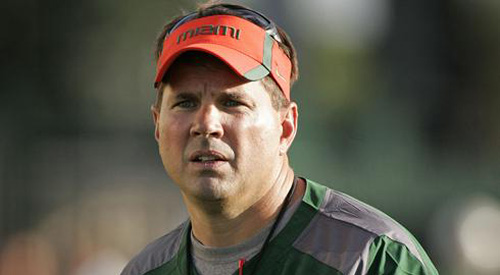
The story of the Hurricanes and what it means for the NCAA
It’s been a scandal-plagued offseason in NCAA football, with Ohio State, Oregon and North Carolina all landing in hot water to one degree or another.
The biggest story of all happened in Florida, though, where an 11-month Yahoo! Sports investigation into repeated NCAA violations by booster Nevin Shapiro at the University of Miami may have uncovered perhaps the biggest scandal since the one that got SMU the death penalty in the 1980s.
The details of the Miami scandal are sensational and sordid, featuring convicted Ponzi-schemer Shapiro allegedly attempting to influence recruits, holding massive mansion and yacht parties for athletes, buying them prostitutes and perhaps even arranging for an abortion.
It’s notable that this wasn’t some anonymous renegade, either, but a guy who was one of the largest donors to the football program, had a regular suite at Hurricanes’ games, had his name on the wall of the players’ lounge and had key administration members like university president Donna Shalala attend his fundraisers. That means the whole Miami administration deserves to be looked at, not just the football players involved.
However, the bigger question is what the Miami case, and the other surrounding scandals this offseason, mean in larger context for the NCAA. The Hurricanes are far from the only offender out there, and although their violations were more spectacular and more widespread than most others that have come to light, that doesn’t mean they’re the only program facing major issues. Their issues also have a lot to say about the state of the NCAA at the moment.
One of the most interesting narratives that’s come out of the Miami case is how the particular circumstances surrounding the Hurricanes’ program may have contributed to this. Yes, Miami’s long been known as “The U” and had a renegade history to go with their swagger (heck, it took a whole documentary to chronicle that), but the Hurricanes have long operated under severe budgetary constraints, particularly on the donor side.
[php snippet=1]
Without as large of a prominent network of boosters, there’s a case to be made that the school was obligated to cater to the ones they did have – and that paved the way for Shapiro’s incredible level of access to players, coaches and administrators, which may have raised many more red flags at other schools.
That’s not to absolve the Hurricanes, as there were plenty of signs that this guy was bad news, but it makes their decision to hold their nose and keep taking his money a little more understandable.
As SB Nation‘s Seventh Floor Blog pointed out, they were competing on a tilted playing field against prominent schools with huge cash resources, which made it difficult to alienate one of the few guys willing to give them large amounts of money:
“The school, and its fans, wanted Miami to wade into the arms race, even though it couldn’t, and can’t. The program was not built with money, and never will be. Miami has some things that 95% of football programs would still kill for (location, history), but a large war chest isn’t one of them. And that left a big void, one that Nevin Shapiro was more than happy to fill, and one that the school was more than happy to let him fill. He did, of course, have money. If Miami had an inkling that some things were going on with Shapiro that shouldn’t have been going on, well, it’s hard to alienate an extremely generous donor when you have very few extremely generous donors.”
Perhaps the old line that money is the root of all evil has some truth to it, as it’s money that can be traced to the root of many of the NCAA’s current problems. Sure, the scandals have involved cash or equivalents (tattoos at Ohio State, phoney scouting services at Oregon, parking tickets at UNC), but the money issues go much further and are severely altering the NCAA landscape.
Consider the Longhorn Network, at the heart of ESPN’s ethical conflicts, and something that may soon set off the dominoes of conference realignment thanks to Texas A&M’s imminent departure from the Big 12. Consider Oregon, Oklahoma State and even Connecticut, where wealthy boosters are exerting major control over athletic department operations.
Money’s at the heart of all of these issues, and its influence will only continue to grow. Television revenues are constantly rising, debates about paying players continue and the arms race to build fancier facilities, develop new uniforms and find other ways to bring in top coaches and recruits isn’t going anywhere.
Miami chose the wrong backer for their arms race attempt, and it’s going to cost them. The issues raised by this scandal go well beyond the Hurricanes, though, and they may affect the future of NCAA football. The influence of cash will only continue to grow, and Shapiro’s far from the only questionable character out there with money to burn.
[php snippet=1]

